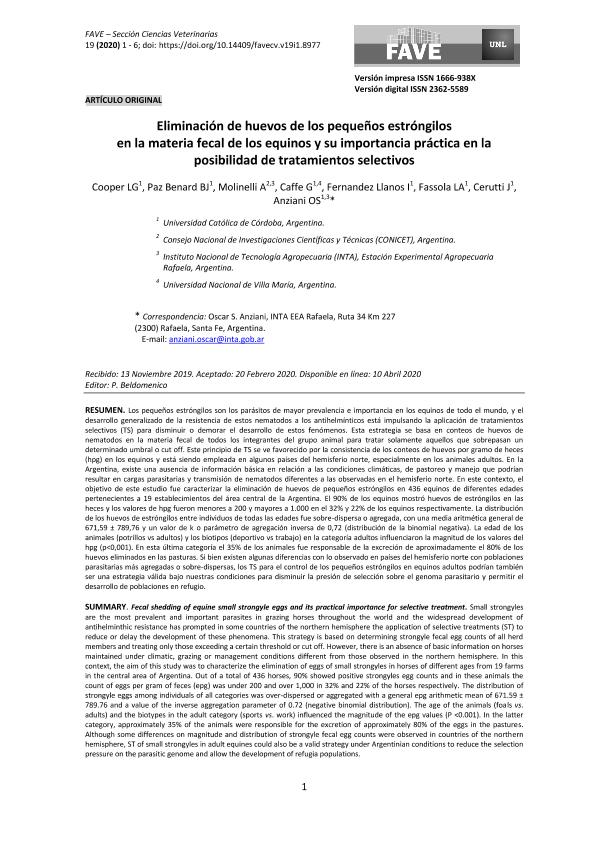Artículo
Los pequeños estróngilos son los parásitos de mayor prevalencia e importancia en los equinos de todo el mundo, y el desarrollo generalizado de la resistencia de estos nematodos a los antihelmínticos está impulsando la aplicación de tratamientos selectivos (TS) para disminuir o demorar el desarrollo de estos fenómenos. Esta estrategia se basa en conteos de huevos de nematodos en la materia fecal de todos los integrantes del grupo animal para tratar solamente aquellos que sobrepasan un determinado umbral o cut off. Este principio de TS se ve favorecido por la consistencia de los conteos de huevos por gramo de heces (hpg) en los equinos y está siendo empleada en algunos países del hemisferio norte, especialmente en los animales adultos. En la Argentina, existe una ausencia de información básica en relación a las condiciones climáticas, de pastoreo y manejo que podrían resultar en cargas parasitarias y transmisión de nematodos diferentes a las observadas en el hemisferio norte. En este contexto, el objetivo de este estudio fue caracterizar la eliminación de huevos de pequeños estróngilos en 436 equinos de diferentes edades pertenecientes a 19 establecimientos del área central de la Argentina. El 90% de los equinos mostró huevos de estróngilos en las heces y los valores de hpg fueron menores a 200 y mayores a 1.000 en el 32% y 22% de los equinos respectivamente. La distribución de los huevos de estróngilos entre individuos de todas las edades fue sobre-dispersa o agregada, con una media aritmética general de 671,59 ± 789,76 y un valor de k o parámetro de agregación inversa de 0,72 (distribución de la binomial negativa). La edad de los animales (potrillos vs adultos) y los biotipos (deportivo vs trabajo) en la categoría adultos influenciaron la magnitud de los valores del hpg (p<0,001). En esta última categoría el 35% de los animales fue responsable de la excreción de aproximadamente el 80% de los huevos eliminados en las pasturas. Si bien existen algunas diferencias con lo observado en países del hemisferio norte con poblaciones parasitarias más agregadas o sobre-dispersas, los TS para el control de los pequeños estróngilos en equinos adultos podrían también ser una estrategia válida bajo nuestras condiciones para disminuir la presión de selección sobre el genoma parasitario y permitir el desarrollo de poblaciones en refugio. Small strongyles are the most prevalent and important parasites in grazing horses throughout the world and the widespread development of antihelminthic resistance has prompted in some countries of the northern hemisphere the application of selective treatments (ST) to reduce or delay the development of these phenomena. This strategy is based on determining strongyle fecal egg counts of all herd members and treating only those exceeding a certain threshold or cut off. However, there is an absence of basic information on horses maintained under climatic, grazing or management conditions different from those observed in the northern hemisphere. In this context, the aim of this study was to characterize the elimination of eggs of small strongyles in horses of different ages from 19 farms in the central area of Argentina. Out of a total of 436 horses, 90% showed positive strongyles egg counts and in these animals the count of eggs per gram of feces (epg) was under 200 and over 1,000 in 32% and 22% of the horses respectively. The distribution of strongyle eggs among individuals of all categories was over-dispersed or aggregated with a general epg arithmetic mean of 671.59 ± 789.76 and a value of the inverse aggregation parameter of 0.72 (negative binomial distribution). The age of the animals (foals vs. adults) and the biotypes in the adult category (sports vs. work) influenced the magnitude of the epg values (P <0.001). In the latter category, approximately 35% of the animals were responsible for the excretion of approximately 80% of the eggs in the pastures. Although some differences on magnitude and distribution of strongyle fecal egg counts were observed in countries of the northern hemisphere, ST of small strongyles in adult equines could also be a valid strategy under Argentinian conditions to reduce the selection pressure on the parasitic genome and allow the development of refugia populations.
Eliminación de huevos de los pequeños estróngilos en la materia fecal de los equinos y su importancia práctica en la posibilidad de tratamientos selectivos
Título:
Fecal shedding of equine small strongyle eggs and its practical importance for selective treatment
Cooper, Laura Gabriela; Paz Benard, Benjamín J.; Molineri, Ana Inés ; Caffe, Gabriel; Fernandez Llanos, Ignacio; Fassola, Luciana Agostina
; Caffe, Gabriel; Fernandez Llanos, Ignacio; Fassola, Luciana Agostina ; Cerutti, Julieta; Anziani, Oscar Sergio
; Cerutti, Julieta; Anziani, Oscar Sergio
 ; Caffe, Gabriel; Fernandez Llanos, Ignacio; Fassola, Luciana Agostina
; Caffe, Gabriel; Fernandez Llanos, Ignacio; Fassola, Luciana Agostina ; Cerutti, Julieta; Anziani, Oscar Sergio
; Cerutti, Julieta; Anziani, Oscar Sergio
Fecha de publicación:
04/2020
Editorial:
Universidad Nacional del Litoral. Facultad de Ciencias Veterinarias
Revista:
Fave. Sección Ciencias Veterinarias
ISSN:
1666-938X
Idioma:
Español
Tipo de recurso:
Artículo publicado
Clasificación temática:
Resumen
Archivos asociados
Licencia
Identificadores
Colecciones
Articulos(CIDIE)
Articulos de CENTRO DE INV. Y DESARROLLO EN INMUNOLOGIA Y ENFERMEDADES INFECCIOSAS
Articulos de CENTRO DE INV. Y DESARROLLO EN INMUNOLOGIA Y ENFERMEDADES INFECCIOSAS
Citación
Cooper, Laura Gabriela; Paz Benard, Benjamín J.; Molineri, Ana Inés; Caffe, Gabriel; Fernandez Llanos, Ignacio; et al.; Eliminación de huevos de los pequeños estróngilos en la materia fecal de los equinos y su importancia práctica en la posibilidad de tratamientos selectivos; Universidad Nacional del Litoral. Facultad de Ciencias Veterinarias; Fave. Sección Ciencias Veterinarias; 19; 1; 4-2020; 1-6
Compartir
Altmétricas



